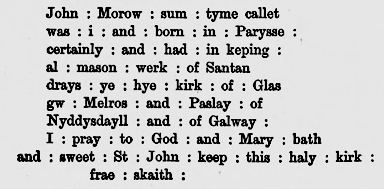Chapter XX: Remains
This inscription runs thus:—

For what portion of our Abbey we are indebted to the skill of Morow we do not know. His name has been rescued from oblivion only by the inscriptions we have given.
We may perhaps fitly notice in this chapter one or two other relics of the olden time, besides those architectural remains which we have described. The first is the seal of the Abbey. This has been lost, but its form is well known from the impression attached to the charters still in existence. On one side of the seal is a figure of St. James with pilgrim's staff and scrip. At each side of the Saint is a shield,—that on his right bearing the fess cheque of the Stewarts, that on his left a saltire cantoned with four roses, the armorial bearings of the family of Lennox, who, with the Stewarts, were great benefactors of the Monastery; above the right shield is a saltire, a crescent, and a star, above the left a saltire and a star. The background is ornamented with foliage, interspersed with crosses, fleury and fleur de lis.[26] On the other side of the seal is a figure of St. Mirin as a vested Bishop, his right hand raised in benediction, and his left holding a crozier. The shields on each side of the Saint are the same as those on the other side of the seal ; above the right shield is a saltire and a crescent, above the left a saltire and a star. On the one side of the seal is the following inscription:—
![]()
The seal of the Chapter of Saint James and St. Mirin of Passelet.
On the other side of the seal is engraved the following prayer:—
![]()
O Mirin! Pray to Christ for thy servants.
The last notice that we have of the common seal of the Abbey is in 1574, in which year Claud Hamilton, the Commendator, brought an action against Lord Sempill,[27] alleging that the latter, during his occupancy of the Abbey, had obtained possession of the seal, and refused to give it up. The judges commanded Lord Sempill, who denied that he ever had the seal, to return it to Claud Hamilton. Whether the Commendator ever received it, we do not know.[28]
[26] See Gordon's Monasticon, p. 556.
[27] Suit by Claud Hamilton, Commendator of Paisley, against Robert Lord Semple, narrating that in the late troubles the said Lord Semple got into his hands the common seal of the said Abbey, with the “buke callit the blak buik of Paslay,” and that he would not return the same. Lord. Semple denied that he ever had the said articles, but the Lords held that the pursuer had proved his point, and granted letters against Lord Semple for the recovery of the seal and book. —Register of Acts and Decreets, Vol. 54, fol. 220, 29th March, 1574.
[28] On the new iron gates of the Abbey there are large, well-executed representations of the seal.